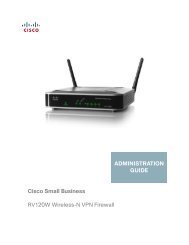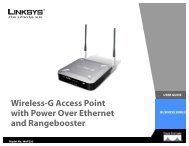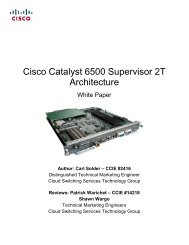Cisco Small Business AP541N Dual-band Single-radio Access Point ...
Cisco Small Business AP541N Dual-band Single-radio Access Point ...
Cisco Small Business AP541N Dual-band Single-radio Access Point ...
You also want an ePaper? Increase the reach of your titles
YUMPU automatically turns print PDFs into web optimized ePapers that Google loves.
Quick Start Guide<strong>Cisco</strong> <strong>Small</strong> <strong>Business</strong><strong>AP541N</strong> <strong>Dual</strong>-<strong>band</strong> <strong>Single</strong>-<strong>radio</strong> <strong>Access</strong> <strong>Point</strong>Quick Start GuidePackage Contents• <strong>Cisco</strong> <strong>AP541N</strong> <strong>Dual</strong>-<strong>band</strong> <strong>Single</strong>-<strong>radio</strong> <strong>Access</strong> <strong>Point</strong> that includes anIEEE 802.11a/b/g/n <strong>radio</strong>.• Three antennas (These might be black or black-and-silver. This does notaffect performance.)• Screws and wallboard anchors• Cat 5e Ethernet cable• Power supply• This quick start guide• Product CD-ROM
WelcomeThank you for choosing the <strong>Cisco</strong> <strong>Small</strong> <strong>Business</strong> <strong>AP541N</strong>. The<strong>Cisco</strong> <strong>AP541N</strong>, part of the <strong>Cisco</strong> Smart <strong>Business</strong> Communications System(SBCS), is an 802.11n wireless access point purposely built for the <strong>Small</strong><strong>Business</strong>.This guide is designed to familiarize you with the general layout of theaccess point, how to deploy the device in your network, and access theconfiguration interface. Your access point has more features orfunctionality than what is described in this guide. For additionalconfiguration information, see the <strong>Cisco</strong> <strong>AP541N</strong> Administration Guideavailable at http://www.cisco.com/en/US/products/ps10492/prod_maintenance_guides_list.html.1Getting to Know the<strong>Cisco</strong> <strong>AP541N</strong>This section describes the exterior of the access point.Front Panel LEDs<strong>Cisco</strong> <strong>Small</strong> <strong>Business</strong> ProRESETPWR PoE DIAG SPEED LAN WLAN 2.4G WLAN 5GAP54 1N <strong>Dual</strong> Band <strong>Single</strong> Radio <strong>Access</strong> <strong>Point</strong>235174<strong>Cisco</strong> <strong>AP541N</strong> <strong>Dual</strong>-<strong>band</strong> <strong>Single</strong>-<strong>radio</strong> <strong>Access</strong> <strong>Point</strong> Quick Start Guide 1
CAUTIONBefore you connect your access point to the network orpower it on, read the “Getting Started with theConfiguration” section.Label Activity DescriptionPWR green Powered on.flash green Firmware upgrade.PoE green Power-over-Ethernet (PoE) is poweringthe access point.Diag red Power-on-self-test (POST).Speed off Data speed is zero or 10 Mbps.amber Data speed is 100 Mbps.green Data speed is 1000 Mbps.LAN solid green A wired network link is established.flash green Passing traffic.WLAN 2.4G solid green A 2.4 GHz wireless network link isestablished.flash green Passing traffic.offThe 2.4 GHz <strong>radio</strong> is off.WLAN 5.0G solid green A 5.0 GHz wireless network link isestablished.flash green Passing traffic.offThe 5.0 GHz <strong>radio</strong> is off.Back Panel PortsEthernet Port—An auto-sensing, Gigabit Ethernet (802.3) port thatsupports Power-over-Ethernet (PoE).NOTEWe recommend using Cat5e or better cable. Also, do not exceedthe maximum cabling distance of 328 feet (100 meters) persegment.ANT01, ANT02, ANT03—RP-SMA connectors that accept the antennasprovided with the access point.2 <strong>Cisco</strong> <strong>AP541N</strong> <strong>Dual</strong>-<strong>band</strong> <strong>Single</strong>-<strong>radio</strong> <strong>Access</strong> <strong>Point</strong> Quick Start Guide
PowerEthernet2351752Getting Started with theConfigurationThis procedure describes how to access the <strong>Access</strong> <strong>Point</strong> ConfigurationUtility:• By using the default IP address of the access point., follow theinstructions in the “Display the Configuration Utility By Using theDefault IP Address” section if you are not using <strong>Cisco</strong> ConfigurationAssistant (CCA).• If you are using the <strong>Cisco</strong> <strong>AP541N</strong> in the DHCP client mode in a networksupported by CCA, follow the instructions in Display the ConfigurationUtility by Using CCA.CAUTIONIf the access point IP address is changed, either by a DHCPserver or manually, your link to the access point will be lostand you must enter the new IP address to use the <strong>Access</strong><strong>Point</strong> Configuration Utility.<strong>Cisco</strong> <strong>AP541N</strong> <strong>Dual</strong>-<strong>band</strong> <strong>Single</strong>-<strong>radio</strong> <strong>Access</strong> <strong>Point</strong> Quick Start Guide 3
Before You Begin1. Verify that you have a power source for the <strong>Cisco</strong> <strong>AP541N</strong>. If you aredeploying the <strong>Cisco</strong> <strong>AP541N</strong> by using PoE, it is necessary totemporarily power the device by using the provided power supply.2. Verify that a PC with Microsoft Internet Explorer (version 6 and higher),Firefox (version 3 or higher), or Safari (for Mac) is available.Display the Configuration Utility By Using theDefault IP AddressThis section describes how to display the <strong>Access</strong> <strong>Point</strong> ConfigurationUtility by using a PC connected directly to the access point.192.168.10.10255.255.255.0192.168.10.250255.255.255.0195057The <strong>Cisco</strong> <strong>AP541N</strong> default IP address is required. If the IP address is of thedevice is unknown, you can reset the device to factory default parametersby using the “Returning the <strong>Cisco</strong> <strong>Small</strong> <strong>Business</strong> Pro AP 541N to theFactory Default Settings” procedure.To configure the access point by using a PC directly connected to the<strong>Cisco</strong> <strong>AP541N</strong>:STEP 1Power on the PC and if you have not already done so, configure thePC IP address to an IP address in the same subnetwork. To changethe PC IP address, do the following:a. From the Windows Start menu, choose Settings > ControlPanel.b. On the Control Panel dialog box, click Network.c. In the Network dialog box select TCP/IP for your PC Ethernetcard, then click Properties.d. In the IP Address window, click Specify an IP address.4 <strong>Cisco</strong> <strong>AP541N</strong> <strong>Dual</strong>-<strong>band</strong> <strong>Single</strong>-<strong>radio</strong> <strong>Access</strong> <strong>Point</strong> Quick Start Guide
STEP 2STEP 3STEP 4STEP 5STEP 6STEP 7e. In the IP Address field, enter an IP address that is in the samesubnet as the access point IP address. (The default accesspoint IP address is 192.168.10.10.) For example, you can setthe:PC IP address to 192.168.10.250PC IP subnet mask to 255.255.255.0f. In the Subnet Mask field, type 255.255.255.0.g. Click OK. Your changes are applied to the PC configuration.h. If you are prompted to restart your PC, click Yes.Connect an Ethernet cable to the Ethernet port on the PC.Connect the other end of the Ethernet cable to the <strong>Cisco</strong> <strong>AP541N</strong>Ethernet port.Power on the access point.Open a Web browser window. If you are prompted to install anActive-X plug-in when connecting to the device, follow theprompts to accept the plug-in.Enter the <strong>Cisco</strong> <strong>AP541N</strong> IP address in the address bar and pressEnter. For example, http://192.168.10.10.The <strong>Access</strong> <strong>Point</strong> Configuration Utility displays.Enter the default login information:Username is ciscoDefault password is cisco (passwords are case sensitive)The Getting Started window displays. You can now configure thedevice for you specific needs.Next, we recommend that you:• Click Change Administrator Password on the Getting Startedpage to change the password.• Click SSID, Guess <strong>Access</strong>, and Security Configuration toconfigure the SSID and enable wireless security.• Click Radio Settings to turn on the Radio Interface. (The <strong>radio</strong>is disabled by default to prevent unauthorized users fromaccessing the network before you have enabled wirelesssecurity on the <strong>Cisco</strong> <strong>AP541N</strong>.)<strong>Cisco</strong> <strong>AP541N</strong> <strong>Dual</strong>-<strong>band</strong> <strong>Single</strong>-<strong>radio</strong> <strong>Access</strong> <strong>Point</strong> Quick Start Guide 5
• If you are not using DHCP on your network, click Change IPAddress to set the Connection Type on the access point toStatic and change the Static IP Address and Subnet Mask to anIP address and subnet mask that matches the IP addressingscheme in your network, so an unknown IP address is notassigned to the access point.When you click Apply, you will lose connectivity. You canreconnect by using the new IP address and password.• Click Upgrade Software to update the <strong>Cisco</strong> <strong>AP541N</strong> with thelatest version of the software.These tasks can be accomplished by using the procedures in the<strong>Cisco</strong> <strong>Small</strong> <strong>Business</strong> <strong>AP541N</strong> <strong>Access</strong> <strong>Point</strong> AdministrationGuide.CAUTIONIf the access point is connected to the network, the<strong>Cisco</strong> <strong>AP541N</strong> has not been set to use a static IP address,and there is a DHCP server on the network, a new IP addresswill be assigned to the access point. To modify theconfiguration you must discover the IP address assigned tothe <strong>Cisco</strong> <strong>AP541N</strong> by using the DHCP server.NOTEWe recommend that you return your PC to its original settings.3Display the ConfigurationUtility by Using CCAUse <strong>Cisco</strong> Configuration Assistant 2.1 or higher (CCA) to configure theaccess point when it is deployed in a <strong>Cisco</strong> Smart <strong>Business</strong>Communications System (SBCS) network with a UC520 or SR520.This procedure assumes you are familiar with CCA. You can find additionalinformation about CCA at http://www.cisco.com/en/US/products/ps7287/tsd_products_support_series_home.html6 <strong>Cisco</strong> <strong>AP541N</strong> <strong>Dual</strong>-<strong>band</strong> <strong>Single</strong>-<strong>radio</strong> <strong>Access</strong> <strong>Point</strong> Quick Start Guide
DHCP clientInternet195058To configure the access point by using CCA:STEP 1STEP 2STEP 3STEP 4STEP 5Connect the Ethernet port on the access point to a switch port on aSBCS device and power on the <strong>Cisco</strong> <strong>AP541N</strong>.Connect a PC with CCA installed to any access switch port on theUC520 or SR520.Create a new CCA site by entering a name and the IP address ofthe UC520 or SR520.Connect to the CCA site by using the appropriate login credentials.Click Window > Topology View.When you have connected to the CCA site and the devices havebeen discovered, the Topology map includes the <strong>Cisco</strong> <strong>AP541N</strong>.NOTEAny non-SBCS devices connected to the switch are not shownin the Topology map.STEP 6STEP 7Right-click the access point to display the options: ConfigurationUtility, Properties, and Annotation.Click Configuration Utility.The <strong>Access</strong> <strong>Point</strong> Configuration Utility displays in a new window.<strong>Cisco</strong> <strong>AP541N</strong> <strong>Dual</strong>-<strong>band</strong> <strong>Single</strong>-<strong>radio</strong> <strong>Access</strong> <strong>Point</strong> Quick Start Guide 7
STEP 8Enter the login information:Username = ciscoDefault password = cisco (Passwords are case sensitive.)The Getting Started window displays.Next, we recommend that you:• Change the password.• Configure the SSID and enable wireless security.• Enable the <strong>radio</strong>. (The <strong>radio</strong> is disabled by default to preventunauthorized users from accessing the network before youhave enabled wireless security on the <strong>Cisco</strong> <strong>AP541N</strong>.)• Update the <strong>Cisco</strong> <strong>AP541N</strong> software with the latest version byusing the Software Upgrade link on the Getting Started page.These tasks can be accomplished by using the procedures in the<strong>Cisco</strong> <strong>Small</strong> <strong>Business</strong> <strong>AP541N</strong> <strong>Access</strong> <strong>Point</strong> AdministrationGuide.Default Wireless Network ParametersThe factory default parameters for the <strong>radio</strong> are:ParameterDefault Valuedata VLAN 1voice VLAN 100data SSID cisco–data (VLAN 1)voice SSID cisco-voice (VLAN 100)scanner SSIDcisco-scan (VLAN 1) WPA Personal securityw/AES. The passphrase is intermec.wireless security None (We strongly recommend that you setwireless security.)CAUTIONWe recommend that you change the password on the accesspoint and enable security on the device and your wirelessnetwork.8 <strong>Cisco</strong> <strong>AP541N</strong> <strong>Dual</strong>-<strong>band</strong> <strong>Single</strong>-<strong>radio</strong> <strong>Access</strong> <strong>Point</strong> Quick Start Guide
Troubleshoot Your ConnectionIf you cannot display the configuration utility, you can test the ability of thePC to communicate with the access point by using ping. To use ping on aPC running Windows:STEP 1STEP 2Verify that the <strong>Cisco</strong> <strong>AP541N</strong> is powered on and the LEDs indicatethe appropriate links.Open a command window by using Start > Run and enter cmd.STEP 3 At the Command window prompt enter ping and the accesspoint IP address. For example ping 192.168.10.10 (thedefault static IP address of the access point).If successful, you should get a reply similar to the following:Pinging 192.168.10.10 with 32 bytes of data:Reply from 192.168.10.10: bytes=32 time
4Returning the <strong>Cisco</strong> <strong>Small</strong><strong>Business</strong> <strong>AP541N</strong> to theFactory Default SettingsTo use the Reset button to reboot or reset the access point, do thefollowing:• To reboot the access point, press the Reset button for less than 10seconds.• To restore the access point to the factory default settings:1. Disconnect the access point from the network or disable all DHCPservers on your network.2. With the power on, press-and-hold the Reset button for more than10 seconds.5Installing the <strong>Cisco</strong> <strong>AP541N</strong>The access point can be placed on a wall, a flat surface, or a ceiling. Aceiling mount kit is available for this device (AP540N-CMK). Do not deploythe device in a location where any of the following conditions exist:High Ambient Temperature—The ambient temperature must notexceed 104 degrees Fahrenheit (40C).Reduced Air Flow—The air flow must be adequate to preventoverheating.Mechanical Overloading—The device should be level, stable, andsecure to avoid it sliding or shifting out of position.Circuit Overloading—Adding the device to the power outlet or a PoEport must not overload that circuit or PoE device.NOTEWe recommend using Cat5e or better cable. Also, do notexceed the maximum cabling distance of 328 feet (100 meters).10 <strong>Cisco</strong> <strong>AP541N</strong> <strong>Dual</strong>-<strong>band</strong> <strong>Single</strong>-<strong>radio</strong> <strong>Access</strong> <strong>Point</strong> Quick Start Guide
Prepare the DeviceTo prepare the device, do the following:STEP 1STEP 2STEP 3Attach the antennas to the RP-SMA connectors labeled ANT101,ANT102, and ANT103. The antennas are all the same, so whichantenna is attached to what connector is of no consequence.Determine where you want to locate the access point. If you areusing AC power, make sure the location is within reach of an ACpower outlet.Keep enough ventilation space for the access point and check forany other environmental restrictions.Wall MountingBefore you begin, you need 2 wallboard screws (included) to mount theaccess point. We recommend using screws with a minimum of 4mm widthat the head and a shaft diameter of at least 1.5mm.WARNINGInsecure mounting might damage the device or cause injury.<strong>Cisco</strong> is not responsible for damages incurred by insecure wallmounting.To mount the access point to the wall:STEP 1STEP 2STEP 3STEP 4Determine where you want to mount the access point. Verify thatthe surface is smooth, flat, dry, and sturdy.Drill two pilot holes into the surface 5.75 inches (146 mm) apart,and with a minimum of 4.0 inches (101 mm) of clearance.Insert a screw into each hole, leaving a gap between the surfaceand the base of the screw head of at least 0.1 inches (3 mm).Place the access point wall-mount slots over the screws and slidethe access point down until the screws fit snugly into the wallmountslots.<strong>Cisco</strong> <strong>AP541N</strong> <strong>Dual</strong>-<strong>band</strong> <strong>Single</strong>-<strong>radio</strong> <strong>Access</strong> <strong>Point</strong> Quick Start Guide 11
Power15 cmEthernet17 mm235432Flat Surface InstallationTo prepare the device for placement the device on a flat surface, do thefollowing:STEP 1STEP 2Install the four rubber feet (included) on the bottom of the device.Place the access point on a desktop near an AC power source,unless you are using PoE.12 <strong>Cisco</strong> <strong>AP541N</strong> <strong>Dual</strong>-<strong>band</strong> <strong>Single</strong>-<strong>radio</strong> <strong>Access</strong> <strong>Point</strong> Quick Start Guide
6Connecting the EquipmentThis section describes the process for connecting the device to powerand the network.STEP 1STEP 2STEP 3Attach the power cord to the power connector and outlet (if used).Connect a network Ethernet cable to the access point Ethernetport.Connect the other end of the Ethernet cable to your network or theEthernet port of the PC you are using to configure the access point.CAUTIONDHCP is enabled by default. If a DHCP server is running onyour network and you have not turned DHCP off, the devicewill accept a new IP address when it is connected to yournetwork. You must use this IP address to configure thedevice.7Verifying the HardwareInstallationTo verify the hardware installation, complete the following tasks:• Check the cable connections.• Check the LED states, as described in the “Getting to Know the<strong>Cisco</strong> AP 541N” section.NOTEIf you need help resolving a problem, visit the <strong>Cisco</strong> <strong>Small</strong><strong>Business</strong> Support Community at www.cisco.com/go/smallbizsupport. For technical documentation and other links, seeWhere to Go From Here, page 14.<strong>Cisco</strong> <strong>AP541N</strong> <strong>Dual</strong>-<strong>band</strong> <strong>Single</strong>-<strong>radio</strong> <strong>Access</strong> <strong>Point</strong> Quick Start Guide 13
8Where to Go From HereSupport<strong>Cisco</strong> <strong>Small</strong> <strong>Business</strong> SupportCommunityOnline Technical Support andDocumentation (Login Required)Phone Support ContactsSoftware Downloads(Login Required)<strong>Cisco</strong> Configuration AssistantProduct Documentation<strong>Cisco</strong> <strong>AP541N</strong> <strong>Dual</strong>-<strong>band</strong><strong>Single</strong>-<strong>radio</strong> <strong>Access</strong> <strong>Point</strong> QuickStart Guide (the latest version)<strong>Cisco</strong> <strong>Small</strong> <strong>Business</strong> ProAP 541N <strong>Dual</strong>-<strong>band</strong> <strong>Single</strong><strong>radio</strong><strong>Access</strong> <strong>Point</strong>Administration Guide<strong>Cisco</strong> AP 541N Ceiling Mount<strong>Cisco</strong> AP 541N Wall MountTemplate<strong>Cisco</strong> <strong>Small</strong> <strong>Business</strong><strong>Cisco</strong> Partner Central for <strong>Small</strong><strong>Business</strong> (Partner LoginRequired)<strong>Cisco</strong> <strong>Small</strong> <strong>Business</strong> HomeMarketplacewww.cisco.com/go/smallbizsupportwww.cisco.com/supportwww.cisco.com/en/US/support/tsd_cisco_small_business_support_center_contacts.htmlGo to tools.cisco.com/support/downloads,and enter the model number in the SoftwareSearch box.www.cisco.com/en/US/products/ps7287/index.htmlhttp://www.cisco.com/en/US/products/ps10492/prod_installation_guides_list.htmlhttp://www.cisco.com/en/US/products/ps10492/prod_maintenance_guides_list.htmlwww.cisco.com/en/US/docs/wireless/access_point/csbap/<strong>AP541N</strong>/ceiling_mount/<strong>AP541N</strong>CeilingMount.pdfhttp://www.cisco.com/en/US/docs/wireless/access_point/csbap/<strong>AP541N</strong>/release_notes/78-19205.pdfwww.cisco.com/web/partners/sell/smbwww.cisco.com/smbwww.cisco.com/go/marketplace14 <strong>Cisco</strong> <strong>AP541N</strong> <strong>Dual</strong>-<strong>band</strong> <strong>Single</strong>-<strong>radio</strong> <strong>Access</strong> <strong>Point</strong> Quick Start Guide
Americas Headquarters<strong>Cisco</strong> Systems, Inc.170 West Tasman DriveSan Jose, CA 95134-1706USAhttp://www.cisco.com<strong>Cisco</strong>, <strong>Cisco</strong> Systems, the <strong>Cisco</strong> logo, and the <strong>Cisco</strong> Systems logo are registered trademarksor trademarks of <strong>Cisco</strong> Systems, Inc. and/or its affiliates in the United States and certain othercountries. All other trademarks mentioned in this document or Website are the property of theirrespective owners. The use of the word partner does not imply a partnership relationshipbetween <strong>Cisco</strong> and any other company. (0705R)© 2010 <strong>Cisco</strong> Systems, Inc. All rights reserved.78-19028-02
















